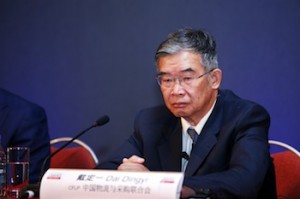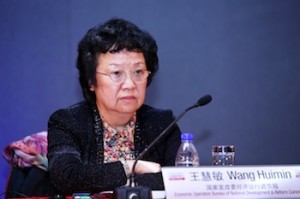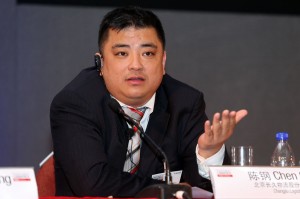Speakers at this year's conference in Beijing revealed that manufacturers and logistics providers are well on their way to further growth in China, but many are still struggling to shift towards higher-value services, as well as fix familiar problems. Additional reporting by Marcus Williams
Full-length videos of the main sessions are now available to watch on the programme page.
 Some themes just don’t get old even after 11 years of Automotive Logistics China conferences: the automotive industry here continues to boom and logistics demand is strong. Following lacklustre growth in 2011 and 2012, last year saw a return to double-digit vehicle sales and production, with expansion across the industry around 10% in the first quarter this year.
Some themes just don’t get old even after 11 years of Automotive Logistics China conferences: the automotive industry here continues to boom and logistics demand is strong. Following lacklustre growth in 2011 and 2012, last year saw a return to double-digit vehicle sales and production, with expansion across the industry around 10% in the first quarter this year.
Government officials have been clear about their ambitions to shift the Chinese economy towards services and consumption, with logistics expected to play an important role. “The logistics industry is in a period of transformation and upgrade, with some companies standing out because of their asset size and service quality,” added Dai Dingyi, vice-president of the China Federation of Logistics and Purchasing (CFLP). “We are seeing these companies acquire others and set up alliances for more advanced services.”
Such messages were aligned to the reform mandates laid down at the end of last year during the communist party’s important ‘third plenum’ conference, which included a subtle but critical shift in economic wording: the market would play a ‘decisive’ role in the economy and in allocating resources, rather than a ‘basic’ one.

“We have confidence in line with the third plenum to accelerate the economic upgrading of China’s logistics industry,” said Wang Huimin, vice-president of the Economic Operation Bureau at the National Development and Reform Commission (NDRC), a central governmental body that steers economic regulation. “The next shift is for companies to move from being logistics providers to supply chain managers.”
Despite the reformist language, it is debatable whether the Chinese automotive logistics industry is keeping up with the mandates. Xu Guangqing, managing director of logistics engineering and operations at Shanghai General Motors, told delegates that the logistics market remains “fragmented” and has failed to make major development over the past decade, despite the overall growth.[sam_ad id=6 codes='true']Chen Gang, vice-president of Beijing Changjiu Logistics, a privately owned logistics provider, complained that OEMs in China tend to ride roughshod over logistics providers, ignoring rising labour and transport costs while demanding constant reductions.
“They ask you to minimise the cost all of the time but don’t do it with justification or a concern for the impact of cost reduction on quality,” said Chen. “They just give a target every year, such as a 10% cost reduction.”
NDRC’s Wang confirmed that profit margins for logistics were around 4% last year in China, well below the average across other industries. She admitted that such levels might not be sustainable as costs continue to rise.
However, while such price pressure may be holding back service developments in some areas, it also part of a productivity drive to help keep China’s manufacturing and supply chain competitive as labour and land costs surge in the country. Carmakers, including Shanghai Volkswagen, FAW-Volkswagen and Qoros, outlined logistics and plant designs to reduce labour, transport and handling costs, for example. Others, such tier supplier Delphi and third party logistics provider UTi Worldwide, revealed plans to roll out major IT and transport management systems to help reduce costs.
Straining to keep up
In the first quarter of 2014, Chinese vehicle sales and production rose around 10% compared to last year to 5.9m units, including 4.86m passenger vehicles. This is tremendous growth considering that the market reached a record 22m vehicles in 2013.
Logistics, meanwhile, is rising at a similar rate to the automotive sector. According NDRC’s Wang, total logistics revenue was up nearly 10% in 2013 compared to 2012. Opportunities for providers are spreading far and wide, with OEMs adding production capacity in both the traditional manufacturing hubs on the east coast around Beijing, Shanghai and Guangzhou, and at an even faster rate in western ‘tier two’ and ‘tier three’ cities like Chongqing, Chengdu and Changsha.

“We have been expanding our capacity across all of our operations and assets to keep up with our customers, including Changan Ford, which grew 50% last year,” said Yang Ming, general manager from Changan Minsheng Logistics. “We have also had to rely on subcontractors to keep up, whom we audit to verify quality.”
Changjiu Logistics’ Chen said that his company had also turned to labour agencies, temporary staff and subcontractors to keep up with growth. He pointed out, however, that these tactics were also used to control costs, and that in some cases they led to poorer quality results.
Follow the links below for comprehensive coverage of news and happenings from throughout the conference.
Watch videos of the key presentations here
- Getting quality as well as growth in logistics
- OEMs and LSPs debate costs
- Big rail reforms could have little impact
- Is China still an LCC sourcing hub?
- Imports are growing but so too could taxes
- Anji Logistics takes to the seas
- Fiat-Chrysler and GAC to build Jeeps in China
- Gefco to expand intra-Asia network
Tier one supplier Delphi has also seen tremendous growth in China, and to meet demand the company is doubling the capacity at its factories in Chongqing and Chengdu, according to Eddie Wright, director of logistics for Asia Pacific. However, Wright said even though Delphi has a ‘Go West’ strategy, its supply base cannot always keep up.
“The problem is bigger for our suppliers, many of which have only just located in Asia Pacific. They might have based themselves in Shanghai and suddenly they’re finding that it is not sufficient,” he said. “But we can’t ask them to add 5-6 locations. We have to figure out how to best optimise with whatever we have.”
Looking to rail
Another area of the supply chain that is growing in China is rail and multimodal transport, although it is still well below the levels than many manufacturers would prefer. According to Gao Feng, general manager of China Railway Special Cargo Services – Automobile, a branch of the state-owned railways that handles vehicle logistics in China, rail volumes expanded some 20% last year to reach 1.2m vehicles, and should reach 1.4m vehicles this year.
Dr Zhang Xiaodong, a specialist in transport at Beijing Jiatong University, also said that China’s reform of the railway ministry, which separated business operations from regulation, should help foster better service and technology. He pointed to ongoing expansion of the rail network, which should reach 120,000km during the current five-year plan. “Investment in bullet trains is freeing up more legacy capacity for freight flows,” he said.
Anji Automotive, meanwhile, has been expanding its operations in short-sea ro-ro and barge shipping. According to Yan Jun, assistant to the general manager, waterborne transport now made up around 20% of the company’s revenue, and he expects that figure to grow to 30%.

While rail transport for parts and material are still rare in China, it has increased for long distance and international flows. Shanghai Volkswagen, for example, now uses rail to move material to its factory in Urumqi, in the far northwest of the country. Others, including Gefco, DB Schenker and Changjiu, are using rail for flows to or from Russia and Europe.
Gao and SGM’s Xu joined others at the conference in pointing out that the use of non-standard, overloaded trucks in China was holding back multimodal services. As has been discussed for many years, carriers in China openly violate official truck limits, hauling oversized trailers that hold as many as 25 vehicles, keeping the cost artificially lower than truck or water transport. “It is a bad situation, and very unsafe,” said Xu.
Logistics on the right path
Despite issues over truck standards and costs, officials and executives at the conference were keen to stress the development of logistics towards higher value services. According to NDRC’s Wang, value-added services for logistics grew by 8.8% in 2013.
Robert Strain, vice-president of the automotive sector for Asia Pacific at Ceva Logistics, stressed that this transformation would be significant for the industry in China. “The supply chain needs to be integrated and highly visible from end to end,” he said. “The move to supply chain management for China will be very significant.”
Ma Zengrong, secretary general of the China Automotive Logistics Association, a branch of CFLP, said that he saw many positive developments among providers. He called Anji Logistics and Changjiu “economic bell weathers” for the sector. “Both of these companies are not only improving services but they have taken an international approach to their businesses,” he said.
"The supply chain needs to be integrated and highly visible from end to end. The move to supply chain management for China will be very significant." - Robert Strain, Ceva Logistics
Changjiu, for example, has opened a division in Germany and is currently working with Audi to move material from Europe to China for production. Anji has also setup international operations, including a joint venture with NYK in Thailand.
Bob DeCrick, head of supply chain management in Asia Pacific for Fiat Chrysler, also had a positive view of logistics provider developments in China. “We have seen a lot of progress. In some cases, [joint venture logistics] partnerships have combined the best of both from around the world,” he said. “I’m also encouraged to see local Chinese logistics providers setting up offices in Germany.”
‘Strained’ partnerships
Not everyone agrees that the sector’s growth has been matched with a rise in quality of service, or that the partnerships between international and Chinese logistics companies have produced such positive results. SGM’s Xu admitted that the relationship between Anji and Ceva, whose joint venture is SGM’s primary 3PL, has been strained at times.
“It is an open secret that we use Anji-Ceva, and that both companies do not always have a very smooth partnership,” he said. “Ceva is a very competitive logistics company globally, but has had to use Anji to understand the market. But China is very complex and difficult to manage. Many providers want to enter the market, and there are already 30m truck drivers living in very poor conditions. It is very hard to compete.”

“Of the multinational companies that have purchased Chinese companies, many have retreated from the market after 3-5 years with their tails between their legs,” he said. “For joint ventures, we see a very adversarial relationship, with a lot of infighting. The multinationals say one thing, while the Chinese partners, who are the ones who have the clout, do another.
“The market is big, but these logistics companies just can’t seem to get to it,” he added.
Beijing Changjiu’s Chen also pointed out that the market is some ways unfair for privately owned operators such as his company, compared to those logistics providers who are subsidiaries of Chinese OEMs.
Some of these dynamics have prevented the creation of more efficient logistics networks and systems in China. SGM’s Xu said that he had not seen major advances over the past decade, despite the tremendous volume increase.
“Logistics in China is fragmented. It would be better if we could see more alliances and collaboration across providers, OEMs and the production network,” he said. “There is a tendency to work in silos, including the government. Often, local governments invest in improvements to logistics in their own cities rather than looking across an entire province, and don’t take a national perspective.”
Ceva’s Strain indicated that big changes to automotive and logistics would come as China eventually followed the reform path laid out during the third plenum conference, particularly should government decrease its support of China’s vast array of state-owned companies and allow the market to determine winners and losers.
“Efficiency must be driven through supply chain management,” he said. “At some point, the government isn’t going to foot the bill anymore.”
Matching productivity to cost rises
The issue of managing cost was central to the conference. Dr Martin Lockström, a professor at the Nordic International Management Society, an expert in supply chain management in China, pointed out that salaries have been increasing in China at an annual rate of 10-15% every year for more than a decade, well above the country’s overall GDP growth and inflation rate. When taking into account the appreciation of the yuan, Lockström said that labour costs had increased by four times in US dollar terms since 2005.
Many companies also pointed to high staff turnover, as employees move quickly to other companies if salary demands are not met.
 Beijing Changjiu's Chen Gang said that carmakers squeezed LSP rates with no consideration for costs in China
Beijing Changjiu's Chen Gang said that carmakers squeezed LSP rates with no consideration for costs in ChinaNot all of these factors are specific to Chinese automotive logistics. Delphi’s Wright pointed out that the need to reduce costs is a “permanent” feature of automotive globally, as is the tendency for low margins in logistics. However, considering China’s fast-rising costs, productivity improvements are increasingly paramount to survival.
That is a challenge that China has mostly been meeting. Lockström pointed to a much sharper rise in labour productivity in China sine the turn of the century than in most other countries. “We can’t be sure what the next ten years will look like, but productivity gains are what will keep manufacturing competitive,” he said.
Lockström predicted that there would be further use of automation and technology in production and logistics, as well as more shifts towards temporary labour and outsourcing. Lockström suggested that major breakthroughs in robotics and 3D printing had the potential to turn industry on its head, with a drastic reduction in labour numbers.
New plant innovations
Indeed, automation and processes to reduce labour in production are already very common across the Chinese automotive supply chain, from in-plant logistics to transport management. Manufacturers are pushing for higher efficiencies through IT, automation, plant design as well as part flows and supplier footprints.
Zhou Zhou, responsible for plant logistics at Shanghai Volkswagen’s Ningo plant, which opened last autumn, revealed innovations that the carmaker had introduced thanks to advanced logistics planning. For example, SVW negotiated a large supplier park with the local government where more than 50% of the parts by value are now based. Those suppliers are fully synchronised into SVW’s ordering and production systems, with 100% delivering just-in-time or just-in-sequence. The carmaker has also organised its inbound supply chain through a system of milkruns, adapting the Volkswagen Group’s ‘new logistics concept’, developed first in Europe.
Ningbo, which builds VW and Skoda models, is the first Volkswagen plant in China to be built according to the group’s standard plant design, allowing the company go from groundbreaking in January 2012 to serial production by October 2013. Among the many now standard design features, the plant includes an optimised parts supermarket and line layout that has helped to reduce in-plant costs, and avoids the need for an external warehouse.
Labour costs are further reduced by the use of 82 automatic guided vehicles. Ningbo also uses around 20% more standard, returnable packaging than VW’s other plants in China, for which the carmaker has also installed an automated conveyor belt to manage the empty containers.
Ningbo has both a very young staff, with an average age of 25, and a high turnover rate, said Zhou. To cope, it has implemented a fast training programme and assigned operator roles that can be learned quickly by new team members.
The plant will eventually have capacity to build 340,000 vehicles a year.
Having a supply chain vision
Another carmaker that has incorporated an integrated, optimised logistics design into its plant is Qoros, a joint venture between Chery and an Israeli investment company. The carmaker’s first plant began production last year in Changshu, 80km outside Shanghai, but began with a “supply chain vision” back in 2010 when the company was planning its operations, according to senior manager of logistics planning, Paulina Chmielarz.
 Paulina Chmielarz pointed to side unloading trucks and a high level of kitting among the innovations for Qoros production
Paulina Chmielarz pointed to side unloading trucks and a high level of kitting among the innovations for Qoros productionOne example is that Qoros started with the intention of building a car to European standards, and so it wanted to be as close as possible to established suppliers, which was one of the reasons it selected Changshu. Qoros is also able to use two supplier parks at the plant: one for suppliers to build complete factories, and another for suppliers who only want to lease land to do warehousing or final sequencing, for example.
Logistics has informed other aspects of Qoros’s production system. For example, the carmaker is using almost 100% kitting of parts to allow the most flexibility on the assembly line and simplify operations. Chmielarz said the kitting is particularly important because Qoros is planning to launch a new vehicle or model every six months. The carmaker is also using a high number of returnable packaging.
Other strategic decisions include the construction of a number of tunnels to move key parts into the factory, including car bodies. “We have also chosen to use only side unloading trucks, so that we can access material quickly if necessary,” said Chmielarz.
‘Game changing’ systems
It is not only in plants or among carmakers that important steps towards efficiency and advanced logistics have been made in China. Eddie Wright revealed that Delphi is in the process of rolling out a global transport management system (TMS) to coordinate its global logistics flows on one platform. The system, which should reach a pilot stage in Asia by the end of the year, will connect orders, transport, payments and customs, and will provide not only visibility of parts but also track the supplier’s global carbon emissions.
“By tracking emissions we will look for ways where we can reduce them, as well as show them to our customers so that OEMs have a more accurate picture of their total emissions,” he said, noting that such reporting could eventually be part of regulatory requirements in China or elsewhere.
"By tracking emissions we will look for ways where we can reduce them, as well as show them to our customers so that OEMs have a more accurate picture of their total emissions" - Eddie Wright, Delphi Asia Pacific
Chris Tiffany, who leads the automotive vertical for logistics provider UTi in Asia Pacific, also revealed that his company is rolling out a global IT management system that should be complete within the next six months, including in China. Tiffany described the system as a “game changer” for UTi, which has still been working through the systems integration of an acquisition splurge that it went on around a decade ago, during which time UTi bought 60 companies.
Tiffany emphasised that it was important that providers and manufacturers relied on systems that went beyond merely sending ASNs or EDI, and should have much higher levels of automation, visibility and route optimisation. “EDI itself is 1990s technology – the industry needs better than that,” he said.
Looking for solutions
Other companies remain on the hunt for better systems and solutions from logistics providers. Jack Huang, director of MRP purchasing and supplier relations at Magna International China, said that because of the tier supplier’s decentralised structure, it was difficult to implement the most efficient logistics network across its 30 plants in China. “Each of our plants has a general manager, who is very powerful. These GMs tend to make most decisions locally,” he said.
Huang said that he was looking for a logistics provider that could provide Magna with a successful case study across a tier one supplier’s production network in China. He commented that it was difficult to get transparent data and pricing information from logistics providers. “But I’m putting the challenge out there to the market to come to me with a successful case to consider,” he said.
While the Chinese automotive logistics market may still be fragmented and inefficient in a number of areas, its improvements and scale are impressive. Along with production and sales growth, providers are pushing new opportunities beyond China’s borders into Russia and Kazakhstan, while also eyeing growth across Asia, including in Thailand, Indonesia and Vietnam.
Back home in China the pace of change and that of wider market reforms may still be unclear, even if officials are all using the same language. But the paths toward expansion are plainly paved for many manufacturers and providers.

























![Global[1]](https://d3n5uof8vony13.cloudfront.net/Pictures/web/a/d/s/global1_726550.svgz)









